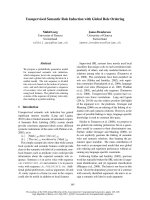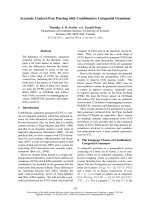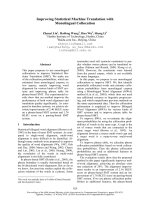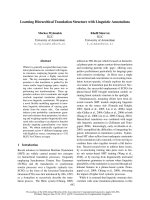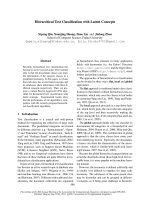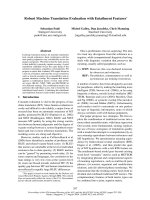Báo cáo khoa học: "Middle bile duct cancer with portal vein tumor thrombus" pps
Bạn đang xem bản rút gọn của tài liệu. Xem và tải ngay bản đầy đủ của tài liệu tại đây (654.79 KB, 5 trang )
BioMed Central
Page 1 of 5
(page number not for citation purposes)
World Journal of Surgical Oncology
Open Access
Case report
Middle bile duct cancer with portal vein tumor thrombus
Mitsugi Shimoda*
1
, Yukihiro Iso
1
, Shigeki Tomita
2
, Takahiro Fujimori
2
,
Koji Murakami
3
, Tokihiko Sawada
1
and Keiichi Kubota
1
Address:
1
Department of Gastroenterological Surgery, Dokkyo University School of Medicine, Tochigi, Japan,
2
Department of Surgical Pathology,
Dokkyo University School of Medicine, Tochigi, Japan and
3
P.E.T Center, Dokkyo University School of Medicine, Tochigi, Japan
Email: Mitsugi Shimoda* - ; Yukihiro Iso - ; Shigeki Tomita - ;
Takahiro Fujimori - ; Koji Murakami - ;
Tokihiko Sawada - ; Keiichi Kubota -
* Corresponding author
Abstract
Background: Tumor thrombus in the portal vein is a common complication of hepatocellular
carcinoma, but an extremely rare complication of common bile duct cancer.
Case presentation: A 78-year-old woman was referred to our department because of jaundice.
Laboratory data showed severe liver dysfunction with high serum levels of total bilirubin and CA19-
9. Computed tomography showed lesions in the middle bile duct and main portal vein. FDG PET
scan and 3D imaging showed hot spots in the same location as those revealed by CT. Under a
diagnosis of middle bile duct cancer with portal vein tumor thrombus, the patient underwent
surgery. At laparotomy, the main tumor was found to be located in the middle bile duct with a
tumor thrombus, 2 cm in diameter, in the main portal vein. The patient underwent
pancreatoduodenectomy with thrombectomy. Histological examination showed that this thrombus
had the same histological features as those of the main bile duct cancer (poorly differentiated
adenocarcinoma). The postoperative course was uneventful and the patient is doing well without
any signs of recurrence 18 months after surgery.
Conclusion: To our knowledge, this is the first report of successful resection of middle bile duct
cancer with portal vein tumor thrombus.
Background
Bile duct cancer (BDC), classified as cancer of the middle
or distal bile duct, was the 6th leading cause of cancer-
related death in Japan in 2004 [1]. Surgical resection
offers the only chance for cure, and the outcome is highly
dependent on surgical skill. In many patients, however,
BDC is unresectable because of associated distant metas-
tasis or involvement of the portal structures or main
artery.
Portal vein tumor thrombus (PVTT) is sometime detected
in patients with advanced hepatocellular carcinoma
(HCC) or hilar cholangiocarcinoma (CCA) by preopera-
tive imaging [2,3]. Although the bile duct is adjacent to
the portal vein anatomically, BDC is rarely complicated
by tumor thrombus in the main portal vein (PV). Here we
present the first reported case of successfully resected mid-
dle BDC complicated by PVTT.
Published: 10 May 2008
World Journal of Surgical Oncology 2008, 6:48 doi:10.1186/1477-7819-6-48
Received: 14 November 2007
Accepted: 10 May 2008
This article is available from: />© 2008 Shimoda et al; licensee BioMed Central Ltd.
This is an Open Access article distributed under the terms of the Creative Commons Attribution License ( />),
which permits unrestricted use, distribution, and reproduction in any medium, provided the original work is properly cited.
World Journal of Surgical Oncology 2008, 6:48 />Page 2 of 5
(page number not for citation purposes)
Case presentation
A 78-year-old woman was admitted to our department
with jaundice in July 2005. Laboratory data showed severe
liver dysfunction with high serum levels of total bilirubin
(7.2 mg/dl: normal less than 1.0 mg/dl) and CA19-9
(7600 U/ml: normal less than 30 U/ml). Computed tom-
ography (CT) showed a mass in the middle bile duct and
main PV (Figure 1a and 1b). Positron emission tomogra-
phy with fluoro-2-deoxy-D-glucose (FDG PET) scan and
3D imaging showed hot spots in the main bile duct and
main PV (Figure 2) and significant development of collat-
eral vessels in the hepato-duodenal ligament. After reduc-
tion of serum total bilirubin, under a diagnosis of middle
BDC with PVTT, the patient underwent surgery. At
laparotomy, the main tumor was located in the middle
bile duct, and a tumor thrombus 2 cm in diameter was
present in the main PV. We performed pancreatoduo-
denectomy (PD) with extraction of the PVTT by PV inci-
sion, because it was unclear whether the cancer had
invaded the PV. Intraoperative ultrasound clearly demon-
strated the PVTT (Figure 3). Macroscopically, there was a
circular lesion obstructing the bile duct, with a fragile
tumor thrombus 2 cm in diameter (Figure 4a,b). Histo-
logical examination showed that bile duct cancer was a
poorly differentiated adenocarcinoma, T4, N2, M0 and
stage IV, according to the AJCC classification [4], and the
thrombus showed the same histological features as those
of the main tumor (Figure 5a,b).
The patient's postoperative course was uneventful. Adju-
vant chemotherapy using Gemcitabine (1200 mg/day for
3 consecutive weeks with a rest in the 4th week) was insti-
tuted 3 months after surgery. Currently, she is doing well
without any signs of recurrence 18 months after surgery.
Discussion
PVTT, which is occasionally observed in HCC, hilar CCA,
pancreatic endocrine tumor and liver metastases from
cancers of the gastrointestinal tract cancer including color-
ectal cancer, is caused by direct cancerous invasion into
the PV and is associated with poor prognosis [2,3,5-8].
HCC shows a high incidence of PV invasion, and is report-
edly found in 64.7% of patients at autopsy [2]. The inci-
dence of PVTT is reported to be 5.3–15.4% in patients
who undergo liver resection [5,6]. The median survival of
patients with HCC and PVTT is only 2.4 months without
treatment, whereas that in patients without PVTT is 24.4
months [9]. The hilar CCA also shows a high incidence of
PVTT, and patients with this type show a slightly lower
survival rate than patients with other types of CCA (intra-
hepatic CCA without portal vein thrombus) [3].
Between 1988 and 1997, 651 cases of BDC were resected
in Japan with a 5-year survival rate of 23% for middle
BDC and 32% for lower BDC [1]. However, there were no
BDC cases complicated by PVTT. Generally, CT and
abdominal ultrasound are helpful for preoperative diag-
nosis of PVTT [10,11]. In the present case, FDG-PET scan
combined with CT clearly demonstrated the main lesion
with PVTT. Development of collateral veins due to portal
occlusion was also clearly visualized. Although PVTT is
extremely rare in BDC, on the basis of these findings we
diagnosed this portal occlusion not as cancer invasion but
as PVTT.
Recently, FDG-PET scan has been widely adopted for diag-
nosis of pancreato-biliary malignancy and metastatic liver
tumors, and is reported to be useful for detection of extra-
a and b. Computed tomography shows the PVTT (white arrow) and bile duct cancer (white dotted arrow)Figure 1
a and b. Computed tomography shows the PVTT (white arrow) and bile duct cancer (white dotted arrow).
World Journal of Surgical Oncology 2008, 6:48 />Page 3 of 5
(page number not for citation purposes)
hepatic metastasis [12-17]. FDG-PET scan combined with
CT will become a key examination for hepato-biliary pan-
creatic malignancies. Although PVTT due to other malig-
nancies is caused by direct invasion of the PV and is
usually connected to the main tumor, in the present case
the connection between the BDC and PVTT was unclear
and there was no clear direct invasion to the PV. There-
fore, combined resection of the PV including the PVTT
was not performed, and the PVTT was extracted by divid-
ing the PV. Although histological examination was also
unable to demonstrate invasion, it is likely that direct
microscopic invasion to the PV would have been present,
resulting in PVTT.
As mentioned above, the prognosis of malignancies asso-
ciated with PVTT is usually poor. Our patient received
standard adjuvant chemotherapy using gemcitabine, [18]
and is currently doing well without any signs of recurrence
18 months after surgery.
Conclusion
We have described the first reported case of BDC with
PVTT, with special reference to the diagnostic utility of
FDG-PET scan. Even if the condition is advanced, surgical
treatment combined with adjuvant chemotherapy may be
feasible in selected patients.
Abbreviations
BDC: Bile duct cancer; PVTT: portal vein tumor throm-
bous; FDG-PET: Positron emission tomography with
fluoro-2-deoxy-D-glucose; PV: Portal vein; HCC: hepato-
cellular carcinoma; CCA: cholangiocarcinoma, PD: pan-
creatoduodenectomy.
Competing interests
The authors declare that they have no competing interests.
Authors' contributions
MS preparation of the manuscript, concept and design
and critically revising the manuscript. YI preparation of
manuscript and concept and design, TS preparation of
manuscript and concept and design, ST preparation of
manuscript and concept and design, TF preparation of
manuscript and concept and design, KM preparation of
manuscript and concept and design, KK preparation of
a and b. A schematic figure, main tumor shows red arrow in the main bile duct and portal vein shows yellow arrowFigure 2
a and b. A schematic figure, main tumor shows red arrow in the main bile duct and portal vein shows yellow arrow. FDG pet
scan with 3-D imaging shows hot spots in the main bile duct (red arrow) and main portal vein (yellow arrow).
Intraoperative ultrasound clearly demonstrates the portal vein tumor thrombusFigure 3
Intraoperative ultrasound clearly demonstrates the portal
vein tumor thrombus.
World Journal of Surgical Oncology 2008, 6:48 />Page 4 of 5
(page number not for citation purposes)
a and b. The main tumor, 3 cm in diameter, was located in the middle bile duct (a: white arrow) (Figure 3a) and the tumor thrombus (b), 2 cm in diameter, was present in the main portal vein (Figure 3b)Figure 4
a and b. The main tumor, 3 cm in diameter, was located in the middle bile duct (a: white arrow) (Figure 3a) and the tumor
thrombus (b), 2 cm in diameter, was present in the main portal vein (Figure 3b).
a and b. Histologically, both the bile duct cancer (Fig. a) and tumor thrombus (Fig. b) show the features of poorly differentiated adenocarcinomaFigure 5
a and b. Histologically, both the bile duct cancer (Fig. a) and tumor thrombus (Fig. b) show the features of poorly differentiated
adenocarcinoma.
Publish with BioMed Central and every
scientist can read your work free of charge
"BioMed Central will be the most significant development for
disseminating the results of biomedical research in our lifetime."
Sir Paul Nurse, Cancer Research UK
Your research papers will be:
available free of charge to the entire biomedical community
peer reviewed and published immediately upon acceptance
cited in PubMed and archived on PubMed Central
yours — you keep the copyright
Submit your manuscript here:
/>BioMedcentral
World Journal of Surgical Oncology 2008, 6:48 />Page 5 of 5
(page number not for citation purposes)
manuscript and concept and design. All authors read and
approved final manuscript for publication.
Acknowledgements
The written consent of the patient was obtained for publication of this case
report
References
1. Nagakawa T, Kayahara M: Tandogan chiryoseiseki ga oshieru
tandogsn no sindan to chiryo noarikata (in Japanese). Kana-
hara shuppan 2005.
2. Poon RT, Fan ST, Lo CM, Liu CL, Wong J: Intrahepatic recurrence
after curative resection of hepatocellular carcinoma: long-
term results of treatment and prognostic factors. Ann Surg
1999, 229:216-222.
3. Isaji S, Kawarada Y, Taoka H, Tabata M, Suzuki H, Yokoi H: Clinico-
pathological features and outcome of hepatic resection for
intrahepatic cholangiocarcinoma in Japan. J Hepatobiliary Pan-
creat Surg 1999, 6:108-116.
4. AJCC Cancer staging manual 6th edition. Springer-Verlag; 2002.
5. Carnero Fernandez M, Morano Amado LE, Bodenlle Bello P, Calvo
Iglesias F: Massive venous thrombosis with cardiac invasion as
primary manifestation of hepatocarcinoma. An Med Interna
2003, 20:537-539.
6. Yamada K, Soejima T, Sugimoto K, Mayahara H, Izaki K, Sasaki R,
Maruta T, Matsumoto S, Hirota S, Sugimura K: Pilot study of local
radiotherapy for portal vein tumor thrombus in patients
with unresectable hepatocellular carcinoma. Jpn J Clin Oncol
2001, 31:147-152.
7. Smith TM, Semelka RC, Noone TC, Balci NC, Woosley JT: Islet cell
tumor of the pancreas associated with tumor thrombus in
the portal vein. Mag Reson Imaging 1999, 17(7):1093-1096.
8. Lee KF, Chu W, Lai PB: Portal vein tumor thrombus in colorec-
tal liver metastasis. Am J Surg 2005, 190:364-365.
9. Llovet JM, Bustamante J, Castells A, Vilana R, Ayuso Mdel C, Sala M,
Brú C, Rodés J, Bruix J: Natural history of untreated nonsurgical
hepatocellular carcinoma: rationale for the design and eval-
uation of therapeutic trials. Hepatology 1999, 29:62-67.
10. Alam H, Kim D, Provido H, Kirkpatrick J: Portal vein thrombosis
in the adult: surgical implications in an era of dynamic imag-
ing. Am Surg 1997, 63:681-684.
11. Dodd GD 3rd, Memel DS, Baron RL, Eichner L, Santiguida LA: Portal
vein thrombosis in patients with cirrhosis: does sonographic
detection of intrathrombus flow allow differentiation of
benign and malignant thrombus? AJR Am J Roentgenol 1995,
165:573-577.
12. Hanajiri K, H Mitsui, T Maruyama, Y Kondo, S Shiina, M Omata: 18F-
FDG PET for hepatocellular carcinoma presenting with por-
tal vein tumor thrombus. J Gastroenterol 2005, 40:1005-1006.
13. Sugiyama M, Sakahara H, Torizuka T, Kanno T, Nakamura F, Futatsu-
bashi M, Nakamura S: 18F-FDG PET in the detection of extra-
hepatic metastases from hepatocellular carcinoma. J
Gastroenterol 2004, 39:961-968.
14. Mansour JC, Schwartz L, Pandit-Taskar N, D'Angelica M, Fong Y, Lar-
son SM, Brennan MF, Allen PJ: The utility of F-18 fluorodeoxyglu-
cose whole body PET imaging for determining malignancy in
cystic lesions of the pancreas. J Gastrointest Surg 2006,
10:1354-1360.
15. Heinrich S, Goerres GW, Schafer M, Sagmeister M, Bauerfeind P, Pes-
talozzi BC, Hany TF, von Schulthess GK, Clavien PA: Positron emis-
sion tomography/computed tomography influences on the
management of resectable pancreatic cancer and its cost-
effectiveness. Ann Surg 2005, 242:235-243.
16. Wakabayashi H, Akamoto S, Yachida S, Okano K, Izuishi K, Nishiyama
Y, Maeta H: Significance of fluorodeoxyglucose PET imaging
in the diagnosis of malignancies in patients with biliary stric-
ture. Eur J Surg Oncol 2005, 31:1175-1179.
17. Anderson CD, Rice MH, Pinson CW, Chapman WC, Chari RS, Del-
beke D: Fluorodeoxyglucose PET imaging in the evaluation of
gallbladder carcinoma and cholangiocarcinoma. J Gastrointest
Surg 2004, 8:90-97.
18. Thongprasert S: The role of chemotherapy in cholangiocarci-
noma. Ann Oncol 2005, 16:93-96.




